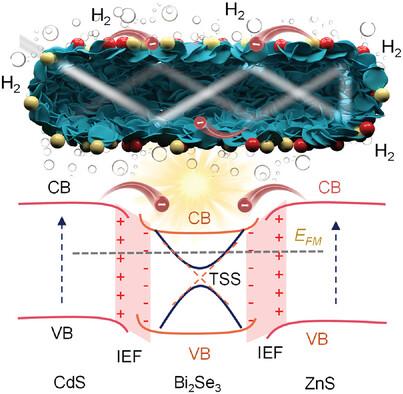当前位置:
X-MOL 学术
›
Adv. Funct. Mater.
›
论文详情
Our official English website, www.x-mol.net, welcomes your feedback! (Note: you will need to create a separate account there.)
Broad Light Absorption and Multichannel Charge Transfer Mediated by Topological Surface State in CdS/ZnS/Bi2Se3 Nanotubes for Improved Photocatalytic Hydrogen Production
Advanced Functional Materials ( IF 18.5 ) Pub Date : 2024-07-01 , DOI: 10.1002/adfm.202407819 Yu‐Tong Xiong 1 , Wei‐Xi Liu 1 , Lin Tian 1 , Ping‐Li Qin 1 , Xiang‐Bai Chen 1 , Liang Ma 1 , Qing‐Bo Liu 1 , Si‐Jing Ding 2 , Qu‐Quan Wang 3, 4
Advanced Functional Materials ( IF 18.5 ) Pub Date : 2024-07-01 , DOI: 10.1002/adfm.202407819 Yu‐Tong Xiong 1 , Wei‐Xi Liu 1 , Lin Tian 1 , Ping‐Li Qin 1 , Xiang‐Bai Chen 1 , Liang Ma 1 , Qing‐Bo Liu 1 , Si‐Jing Ding 2 , Qu‐Quan Wang 3, 4
Affiliation

|
Semiconductor heterojunctions have garnered extensive interest in photocatalytic hydrogen generation, yet the limited light absorption and charge transfer efficiencies still restrict the photocatalytic performance. The topological insulator has unique surface states and high-mobility electrons, demonstrating the significant potential for enhancing photocatalysis. Herein, a ternary photocatalyst based on a topological insulator, in which CdS and ZnS nanoparticles are grown on Bi2Se3 nanotube, is prepared for efficient photocatalysis driven by topological surface state for the first time. Under simulated solar light irradiation, the CdS/ZnS/Bi2Se3 nanotubes display a robust photocatalytic hydrogen production rate of 7.13 mmol h−1 g−1, which is 69.2 times of CdS and comparable to many CdS-based photocatalysts. The unique hollow structure, topological surface state of Bi2Se3, and cooperative bandgap excitations of the three components endow the hybrids with wide light response to harvest solar energy. Meanwhile, the multichannel charge transfer facilitated by topological surface state and internal electric fields within the hybrids effectively suppresses the recombination of the photogenerated charge carriers. This mechanism maintains a high concentration of stable electrons on Bi2Se3, resulting in highly efficient hydrogen production. This work provides a new inspiration for designing heterojunction photocatalysts based on topological insulators for high-efficiency solar-driven energy conversion.
中文翻译:

CdS/ZnS/Bi2Se3 纳米管拓扑表面态介导的宽光吸收和多通道电荷转移可改善光催化产氢
半导体异质结在光催化制氢方面引起了广泛的兴趣,但有限的光吸收和电荷转移效率仍然限制了光催化性能。拓扑绝缘体具有独特的表面态和高迁移率电子,展现出增强光催化作用的巨大潜力。本文制备了一种基于拓扑绝缘体的三元光催化剂,其中 CdS 和 ZnS 纳米颗粒生长在 Bi 2 Se 3 纳米管上,可用于由拓扑表面态驱动的高效光催化第一次。在模拟太阳光照射下,CdS/ZnS/Bi 2 Se 3 纳米管表现出 7.13 mmol h −1 g −1 ,是CdS的69.2倍,与许多CdS基光催化剂相当。独特的中空结构、Bi 2 Se 3 的拓扑表面态以及三个组分的协同带隙激发赋予了杂化物以宽广的光响应来收集太阳能。同时,杂化物内的拓扑表面态和内部电场促进的多通道电荷转移有效地抑制了光生电荷载流子的复合。这种机制在 Bi 2 Se 3 上保持高浓度的稳定电子,从而实现高效的氢气生产。这项工作为设计基于拓扑绝缘体的异质结光催化剂用于高效太阳能驱动的能量转换提供了新的灵感。
更新日期:2024-07-01
中文翻译:

CdS/ZnS/Bi2Se3 纳米管拓扑表面态介导的宽光吸收和多通道电荷转移可改善光催化产氢
半导体异质结在光催化制氢方面引起了广泛的兴趣,但有限的光吸收和电荷转移效率仍然限制了光催化性能。拓扑绝缘体具有独特的表面态和高迁移率电子,展现出增强光催化作用的巨大潜力。本文制备了一种基于拓扑绝缘体的三元光催化剂,其中 CdS 和 ZnS 纳米颗粒生长在 Bi 2 Se 3 纳米管上,可用于由拓扑表面态驱动的高效光催化第一次。在模拟太阳光照射下,CdS/ZnS/Bi 2 Se 3 纳米管表现出 7.13 mmol h −1 g −1 ,是CdS的69.2倍,与许多CdS基光催化剂相当。独特的中空结构、Bi 2 Se 3 的拓扑表面态以及三个组分的协同带隙激发赋予了杂化物以宽广的光响应来收集太阳能。同时,杂化物内的拓扑表面态和内部电场促进的多通道电荷转移有效地抑制了光生电荷载流子的复合。这种机制在 Bi 2 Se 3 上保持高浓度的稳定电子,从而实现高效的氢气生产。这项工作为设计基于拓扑绝缘体的异质结光催化剂用于高效太阳能驱动的能量转换提供了新的灵感。






































 京公网安备 11010802027423号
京公网安备 11010802027423号